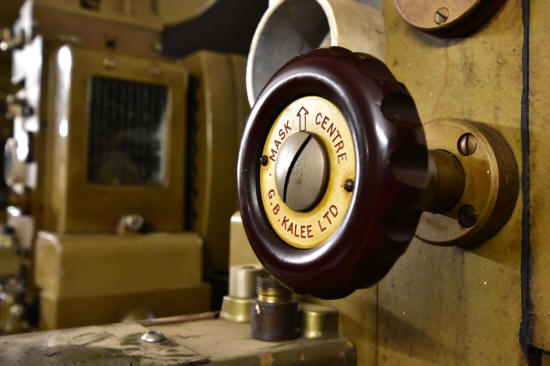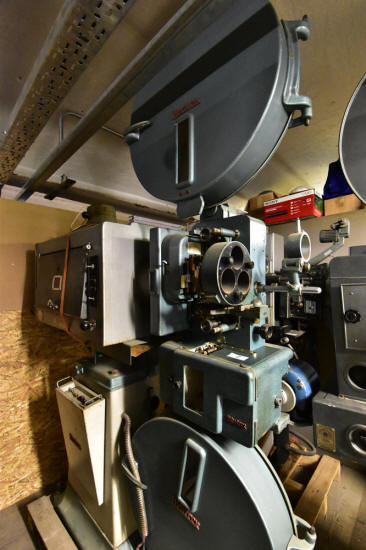The Projected Pictures Trust |
Read more at in70mm.com The 70mm Newsletter |
| Written by: Thomas Hauerslev | Date: 21.01.2019 |
 Thomas
Hauerslev, Bill Lawrence and Dion Hanson between a pair of curry-colored
Gaumont-Kalee machines on 12 January 2019. Thomas
Hauerslev, Bill Lawrence and Dion Hanson between a pair of curry-colored
Gaumont-Kalee machines on 12 January 2019.What is "The Projected Pictures Trust" really? The PPT was started in November 1978 by a group of people with a passion for film projection. The PPT is organized all over the United Kingdom with six regional coordinators who take care of the cinema heritage. The president of the Trust is none other than Sir Sydney Samuelson, who started his projectionist career as a rewind-boy at the Luxor Lancing in September 1939. The PPT have around 100 members mostly in the UK, with some overseas members too. In 2001, in70mm.com contributor and PPT North West Regional Coordinator Mike Taylor wrote this text about the "The Projected Pictures Trust", titled "The PPT Looking after cinemas heritage":
As a projectionist myself, I was always intrigued by the PPT, and
their efforts of collecting vintage projection equipment, however, I never managed to visit or
see the PPT collection and exhibition at Bletchley Park near London (where the Enigma code
was deciphered during WW2). In 2014-15 the PPT moved out of Bletchley
Park, and into G-Mill of Dean Clough,
in Halifax in West Yorkshire. This was my opportunity to see the collection and
catch up with PPT Technical Advisor Dion Hanson, and PPT North East Regional
Coordinator Bill Lawrence who lives in Halifax. Unlike the location in London, the current PPT
collection is not a museum and open to the public. The Dean Clough buildings are among the largest
factory buildings in the world, and were used for the wool industry in Yorkshire
during the "good old days". The carpet factory in Dean Clough closed
in 1983. Since then, the factory building complex has been listed, and today hundreds of small business, restaurants and offices have
moved in instead. |
More in 70mm reading: Go to the gallery: The Projected Pictures Trust, Halifax Go to the gallery: Odeon Halifax (1938-1975) as Mecca Bingo Club The PPT Looking after cinemas heritage Join The Projected Picture Trust! 70mm Film Projectors 1930's Large Format Equipment at the USC Archive The Cinema Museum, London Sir Sydney Samuelson Internet link: The Projected Picture Trust Dean Clough Mills, Halifax, West Yorkshire, HX3 5AX, United Kingdom |
 What is the purpose of the PPT? What is the purpose of the PPT?
Behind a heavy iron door in the basement of
Dean Clough, a huge room opened up in front of me. What a sight. Long
lines of old projectors, one after another. What seemed to be an almost endless
row of machines turned out to be only a small part of the collection. I'd
estimate that at least 50 machines, with lamp houses and spool boxes were stored
in this room - maybe even more. Each machine was placed on its own separate EUR
pallet to make moving relatively easy. |
|
 A
Westrex 70mm projector produced in England. A
Westrex 70mm projector produced in England.Bill and I walked along the passageway through the machines, turned left, and left again until we met Dion who was working in the "office". A room hidden away behind the projectors. In the middle of the room two tables and chairs around them. Alongside the rear wall, two old computers with Windows Xp, and a printer. Next to the PC, 5-6 filing cabinets with what seemed like endless folders and documents about projectors. Manuals, adverts, brochures and flyers. Everything "in progress" to be catalogued, filed and recorded by PPT Archivist and Librarian Tom Harris. The PPT also have a large collection of trade magazines, which are also stored here. Unlike Bletchley Park where rain came through the roof, the Dean Clough facility is very dry, and instead of water, dust is a problem. Opposite the filing cabinets, a working table with a Dolby CP200, and several more instruments for making repairs of cinema sound equipment. Behind it, a regular workshop to repair and fix complete film projectors. One of the PPT's goals is to rent out machines - including a projectionist - for a variety of projects. Special screenings in old cinemas, or for film productions ["The King's Speech"], and before they leave Dean Clough, the machines must be prepared to full working order. The PPT have a large collection of spare parts, so it is hard to imagine something being beyond repair. If they don't have a particular part, it can be made. After a cup of tea (Brown water for me, please, no milk or sugar) Dion gave us a presentation tour around the projectors and equipment, while sharing facts and anecdotes from his 50 years in the business. Some of the Kalee machines came out of the deLuxe laboratory in London and had been built to special specifications to run picture and sound separately. Nearly in mint condition, the paint was still the classic curry-yellow hammertone finish. Another interesting thing which was saved from deLuxe was some sort of projection printing lens. It was a special bench made of three cinema projection lenses to optically print 65mm to 35mm, according to Dion's theory. It was interesting to see two flat lenses and an anamorphic lens locked together. deLuxe in England never made 70mm prints, but maybe they made 65mm reductions to 35mm? We passed several shelves filled with motors for different kinds of Cinemeccanica machines and 35mm spool boxes and endless rows of lamp houses in all shapes, color and sizes. Stored next to each other were two Cinemeccanica machines. A Victoria 8 and the older sibling, a Victoria X fitted with a Super Zenith 450 lamp house. There were many Victoria 8 machines in England, as they were imported as 70mm machines, to avoid tax. Only later, they were converted 35mm projection upon installation. Around the corner, hidden behind more projectors, was a stock of projection lenses (with lots of dust), and sound readers for SDDS, Dolby Digital and DTS/DATASAT, as well as 35mm sound heads of several different brands. The lenses covered many years of history. From older CinemaScope optics made by Carl Zeiss to the latest Blue Star Isco anamorphic lenses, as well as prism anamorphic projection lenses from Kalee. One thing we didn't see were a set of reel towers or a non-rewind system. There were no Philips DP70 Todd-AO projectors in storage, however, as mentioned we did spot a Westrex 70mm projector, as well as two Cinemeccanica 70mm machines. Once in a while, new vintage projectors are offered from collectors. In some cases they are accepted into the "family", but not always. If a projector is already represented in the collection, sometimes with several machines of the same brand and type, the offer is politely turned down. |
|
|
|
|
| Go: back - top - back issues - news index Updated 22-01-25 |

